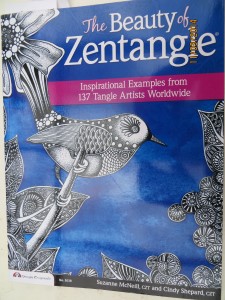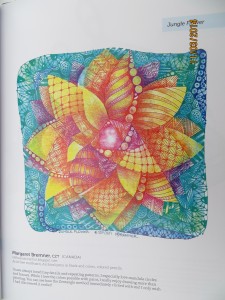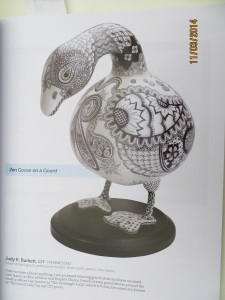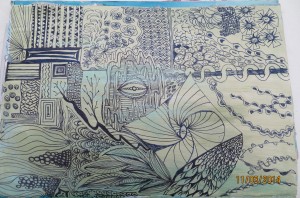~ * ~
This Book Review was written by Anne Maslin
“The Beauty of Zentangle” is published by Design Originals.
Oh what freedom! Oh what joy! Just doodle with a pen. No rules, no focal point, no reason or meaning. Just do it. Make mistakes, no one will know. Copy the patterns given in the book or develop your own using the given ideas. Put the Zen into Zentangles, it’s an experience that is liberating, relaxing and therapeutic. ‘The Beauty of Zentangles’ shows you how.
Take this book on any level you want. Inspiration, instruction, a jumping-off board. Overcome those blank page blues, just doodle. The two authors of ‘The Beauty of Zentangles’, Suzanne Mc Neill and Cindy Shepard provide a comprehensive overview of possibilities. Suzanne has applied her extensive experience in art and design to taking the commonplace doodle to an art form in its own right. She has received a ‘Designer of the Year award and CHA gave her a ‘Lifetime Achievement Award’, not earned lightly. Cindy loves experimenting with mixed media, showing that Zentangles can be applied to any surface – ceramics, wood, quilting, birdhouses, even boots. She has developed her own rubber stamps using her zentangle designs. Both authors are CZT (Certified Zentangle Teachers) but anyone can do a zentangle, especially after reading their book.
Decorate anything. The book gives some gorgeous examples of applying zentangle designs to any surface. The authors use and acknowledge the work of many artists and include illustrations, some in colour, to showcase how zentangles can be incorporated into the design on paper and 3D objects. The illustrations are accompanied by a little note from the artist, explaining their picture. The ‘Goose on a Gourd’ by Judy Burkett is attention-grabbing and would take its place in any art gallery.
Colour it. The zentangle lends itself to the simplicity and the elegant impact of black and white. But some love to colour a space; the zentangle is so inviting and takes the doodle to another level. Any medium: pens, paints, crayons, markers can be used. The authors selected the work of many artists who coloured their zentangles. For example the ‘Jungle Flower’ by Canadian artist Margaret Bremner. Margaret describes how she loved to draw but not paint. The zentangle style allowed her to add colour and she wished she had discovered it earlier.
Need instructions? The authors have included the specific designs of some artists, who demonstrate how they developed the design. Some of these instructions are easy to follow, some need a bit of working out. But hey, by making mistakes, new tangles emerge. So never run out of ideas again!
I have not read this book from front cover to back. I concentrated on a few pages and studied them closely. But that leaves more delights to come. It was a lot of fun tracking the development of designs. This book is very comprehensive and is highly recommended as a resource, especially when faced with a daunting blank page.
You can read more about Zentangles on their website: Zentangle Blog
~*~*~*~*~*~*~*~*~*~*~*~*~*~*~*~*~*~*~*~*~*~*~*~*~
Anne Maslin lives in Melbourne Australia
~*~*~*~*~*~*~*~*~*~*~*~*~*~*~*~*~*~*~*~*~*~*~*~*~
.
.







We would love to hear from you